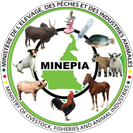Fisheries Production Development Program (Program 057)
2. PROGRAM STRATEGY
The Government's strategy is to remove the constraints that prevent responsible fisheries management and the sustainable development of aquaculture. The three-year objective for the period 2023-2025 for MINEPIA is to increase the supply of fishery and aquaculture products by 7.5%.
National aquaculture production, mainly from fish ponds, remains lower in the face of a demand for fish that peaks at more than 400,000 tonnes per year. Fish products contribute to 13.4% of the animal-based protein intake of consumers' diets for an estimated consumption of 15.4 kg/year/capita, (FAO). To cover the ever-increasing needs over the years, and due to a galloping population, Cameroon has just developed and adopted the National Development Strategy 2020-2030 (SND30) which is now the new reference framework for development actions during the decade.
The SND30 assigns is based on four (04) pillars, all important, the most dynamic of which here is pillar one (01) which is "the structural transformation of the national economy" which consists of emphasizing the low productivity of family farms in rural areas and on the organization and capacity building of actors.
Through the Rural Sector Development Strategy (SRDS) developed and validated in 2020 and which covers the period 2020-2030, the Government has set itself the objectives of moving to an aquaculture production of 25,000 tons in 2025-2027 and 50,000 tons in 2030 with the contribution of the private sector and Decentralized Local Authorities (CTDs) to contribute to the reduction of imports and ensure the policy on import substitution.
Thus, MINEPIA has set up Program 057 entitled "Development of fish production" which is aligned with the axis relating to agro-industrial industry and services and integrated development of priority agro-industrial sectors emphasizing on:
- increase in the production and productivity of agro-pastoral and fishery products
- increasing the productivity, production and competitiveness of pastoral and fishery products;
- access to production equipment and infrastructure;
- strengthening the legislative and regulatory framework and supporting producers;
All this through better monitoring, control and surveillance of fishing activities, the fight against IUU fishing, the reduction of post-harvest losses, the training of fisheries and aquaculture stakeholders as well as equipment support, the development of intensive aquaculture and the development of infrastructure.
3. PROGRAM ACTION
In 2018, the program underwent a redesign with the support of the European Union and its actions were reformulated, going from three (03) to four (04) actions, which are:
- Action 01: Control of capture fisheries production
- Action 02: Development of intensive aquaculture
- Action 03: Support and advice to stakeholders
- Action 04: Programme management
This program is now under the responsibility of Dr. KEMGANG Henry Serges.
| Indicator | Unit of Measurement | Achievements | Targets | ||||||
| Unit of Measurement | 2021 | 2022 | 2023 | 2024 | 2025 | 2026 | 2027 | 2030 | |
| Rate of increase in the quantities of fishery products | % | 2,5 | 5,5 | 4,71 | 6,9 | 8,3 | 8,75 | 9 | 10 |
To improve the achievement of the program's results, the indicators are expressed in terms of the quantity of fishery and aquaculture products available and the decrease in the volume of imports.
4. OBJECTIVES AND PERFORMANCE INDICATORS
| PROGRAMME/ACTION | OBJECTIVE | INDICATORS | UNIT | SOURCE OF AUDIT | REALIZATION | ESTIMATE | TARGET VALUE | 2030 | ||
| 2023 | 2024 | 2025 | 2026 | 2027 | ||||||
| PROGRAM 057 | Ensuring a growing and sustainable production of fish products | Rate of increase in the quantities of fishery products | % | MINEPIA Statistical Yearbook, Report of the MINEPIA Decentralised Services and Studies
on the statistical data. |
4,71 | 6,9 | 8,3 | 8,75 | 9 | 10 |
| DEVELOPMENT OF
PRODUCTIONS FISHERIES |
||||||||||
| ACTION 01
Control of capture fisheries production |
Increasing capture fisheries production | Quantity of fishery products landed | t | MINEPIA Statistical Yearbook, Report of the MINEPIA Decentralised Services and previous studies on statistical data. | 237 270 | 274 693 | 280 186 | 299 416 | 422 650 | 429 241 |
| ACTION 02
Development of intensive aquaculture |
Increasing aquaculture production | Quantity of aquaculture products obtained | t | Report of the decentralised services of the
MINEPIA, document for the census of aquaculture farms in the five regions with high aquaculture potential |
8 676 | 12 645 | 10 045 | 10 949 | 15 455 | 20 015 |
| ACTION 03
Advice support to stakeholders |
Improving the support and supervision of actors | Number of supported producer organisations | nb | Report of the decentralised services of MINEPIA,
Directory of aquaculturists, projects and Programs |
150 | 160 | 170 | 180 | 190 | 250 |
| ACTION 04
Program management |
Promote the overall performance of the program and the achievement of its objectives | Rate of completion of budgeted activities within the program. | % | - Activity report of the sub-directorates - Activity report of the various structures of the programme -
Report on projects and programmes Report on training schools. |
97,86 | 100 | 100 | 100 | 100 | 100 |
5. ACTORS IN THE PERFORMANCE OF THE PROGRAM N°057
- the Directorate of Fisheries, Aquaculture and Fisheries Industries,
- the Directorate in charge of Infrastructure,
- the Regional Delegations,
- the attached services and bodies under supervision (the Maritime Fishing Development Fund (CDPM), the Mission for the Development of Artisanal Maritime Fisheries (MIDEPECAM),
- the Limbe Nautical Arts and Fisheries Industries (LINAFI);
- aquaculture stations;
- CECOPAK;
- Decentralized Local Authorities.
- Projects (PDCEVEP, LIFIDEP, PULCCA, PATNUC...)
The actors in the private sector are fishermen, shipowners, processors and fishmongers as well as importers.













